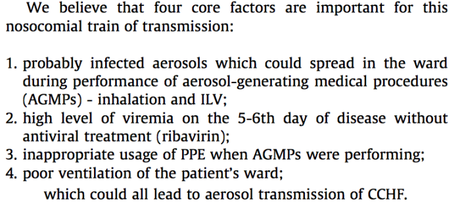This has got to be scary stuff right there. In a paper published in the International Journal of Infectious Diseases, authors contend that it is possible that eight healthcare workers were infected by the CCHF virus while engaged in patient care, and not all of them were in contact with the blood or bodily fluids of the patient; they were, however, exposed to aerosol generating medical procedures. This is only the third time that a possible aerosol route of transmission has been incriminated for the spread of CCHF. The current report comes from Rostov, in Russia, which is endemic for the CCHF virus. The previous two cases reported in the literature originated in Turkey.

The paper also identifies the eight healthcare workers who contracted the illness:
Secondary cases:
#1. Nurse from infectious diseases department, who performed intravenous injections through a catheter, and monitored inhalation use hourly;
#2. Nurse from the infectious diseases department, who assisted in central venous catheterization, performed intravenous injections through a catheter, and monitored inhalation use hourly;
#3. Nurse from the intensive care unit (ICU) department, who installed the equipment for artificial lung ventilation (ALV) within a 20 minute period. She had no direct or potential indirect contact with the patient’s body or her biological fluids, and did not participate in inhalation or ventilation of the patient;
#4. Hospital attendant from the infectious diseases department, who performed change of linen, cleaning room, and disinfection of the bedpan;
#5. Anesthetist from the ICU, who was in the ICU ward not more than 10 min, while the patient was in the ventilator. She had no direct or potential indirect contact with the patient or her biological fluids, and did not participate in inhalation or ventilation of the patient;
#6. Clinician from the infectious diseases department who attended the patient, doing rounds when she was in the ventilator. This physician also treated 2 more CCHF patients at the same time.
#7. Anesthesiologist from the ICU who took care of the ventilator treatment (ALV) of the patient in ICU;
#8. Obstetrician from the gynecology department who examined the patient from the first day of admission to the hospital until the death of the index patient.
Considering that the third and fifth patients had no other epidemiological determinant known to cause the spread of CCHF virus, and the fact that they were involved in potentially aerosol generating medical procedures, it stands to reason, by logic of exclusion, that they were exposed via aerosolized virus. If that is indeed the truth, then it is a potentially scary development because it then raises the ugly issue of biological warfare and the potential of this virus, which has the potential to be lethal, spread rapidly, and cause an epidemic in congested, heavily populated cities being used in acts of bioterrorism.
However, there should be an element of doubt considering the multifarious exposures a healthcare worker may be vulnerable to. One can only hope for the sake of humanity that the fears of viruses like the CCHF virus or the Ebola virus spreading by aerosols is nothing but scientific urban legend.

